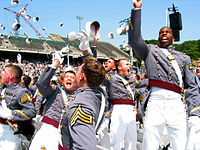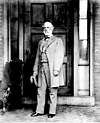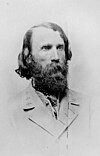List of Confederate States Army officers educated at the United States Military Academy: Difference between revisions
m Removing under construction template from inactive article using AWB |
|||
| Line 1: | Line 1: | ||
{{underconstruction}} |
|||
[[File:WestPointHatToss2002.jpg|thumb|200px|right|Traditional hat toss at the 200th anniversary graduation ceremony at the [[United States Military Academy]] June 7, 2002]] |
[[File:WestPointHatToss2002.jpg|thumb|200px|right|Traditional hat toss at the 200th anniversary graduation ceremony at the [[United States Military Academy]] June 7, 2002]] |
||
[[File:Confederate flag.jpg|thumb|125px|right|Confederate flag]] |
[[File:Confederate flag.jpg|thumb|125px|right|Confederate flag]] |
||
| Line 161: | Line 159: | ||
|last=Sibley |
|last=Sibley |
||
|year= 1838 |
|year= 1838 |
||
|nota= [[History of Confederate States Army Generals#General|Major General CSA]]; [[Second Seminole War]], [[Mexican–American War]], [[Utah War]]; leader of the failed [[New Mexico Campaign]]; [[court martial|court marialed]] and [[censure |
|nota= [[History of Confederate States Army Generals#General|Major General CSA]]; [[Second Seminole War]], [[Mexican–American War]], [[Utah War]]; leader of the failed [[New Mexico Campaign]]; [[court martial|court marialed]] and [[censure]]d in 1863 |
||
|ref={{cref|b}}<ref name="sidley">{{cite web|url=http://www.tshaonline.org/handbook/online/articles/SS/fsi1.html|title=Sidley, Henry Hopkins|work=The Handbook of Texas Online|publisher=Texas State Historical Association|accessdate=2009-07-26}}</ref>}} |
|ref={{cref|b}}<ref name="sidley">{{cite web|url=http://www.tshaonline.org/handbook/online/articles/SS/fsi1.html|title=Sidley, Henry Hopkins|work=The Handbook of Texas Online|publisher=Texas State Historical Association|accessdate=2009-07-26}}</ref>}} |
||
{{mem/a2 |
{{mem/a2 |
||
| Line 282: | Line 280: | ||
{{United States Military Academies and Colleges}} |
{{United States Military Academies and Colleges}} |
||
{{DEFAULTSORT:List Of United States Military Academy Alumni (Confederate States Army)}} |
|||
[[Category:Lists of people by institutional affiliation|West Point]] |
[[Category:Lists of people by institutional affiliation|West Point]] |
||
[[Category:United States Army lists|Academy alumni, famous list]] |
[[Category:United States Army lists|Academy alumni, famous list]] |
||
Revision as of 11:40, 14 August 2009


The United States Military Academy (USMA) is an undergraduate college in West Point, New York that educates and commissions officers for the United States Army. The Academy was founded in 1802 and graduated its first class in October of the same year. It is the oldest of the five American service academies. Sports media refer to the Academy as "Army" and the students as "Cadets"; this usage is officially endorsed.[1] A few graduates each year are given the option of entering the United States Air Force, United States Navy, or United States Marine Corps. Before the founding of the United States Air Force Academy in 1955, the Academy was a major source of officers for the Air Force and its predecessors. Most cadets are admitted through the congressional appointment system.[2][3] The curriculum emphasizes various fields in sciences and engineering.[4][5]
This list is drawn from ...
Other notable graduates include 2 Presidents of the United States, 18 astronauts, 4 heads of state, 74 Medal of Honor recipients,[6] 70 Rhodes Scholars, and 3 Heisman Trophy winners.[7] Among American universities, the Academy is fourth on the list of total winners for Rhodes Scholarships, seventh for Marshall Scholarships and fourth for Hertz Fellowships.[8]
Confederate States Army officers
- Note: "Class year" refers to the alumni's class year, which usually is the same year they graduated. However, in times of war classes often graduate early.
- Beverly Robertson, Class of 1849 (CSA)
- Edmund Kirby Smith, Class of 1845 (CSA)
- Gustavus Woodson Smith, Class of 1842 (CSA)
- George H. Steuart, Class of 1848 (CSA)
- Earl Van Dorn, Class of 1842 (CSA)
- Cadmus M. Wilcox, Class of 1846 (CSA)
- Richard H. Anderson, Class of 1842 (CSA)
- Seth Barton, Class of 1849 (CSA)
- William Beall, Class of 1848 (CSA)
- Dabney H. Maury, Class of 1846 (CSA)
- Samuel B. Maxey, Class of 1846 (CSA)
- John P. McCown, Class of 1840 (CSA)
- Lafayette McLaws, Class of 1842 (CSA)
- George Pickett, Class of 1846 (CSA)
- Simon Bolivar Buckner, Sr., Class of 1844 (CSA)
- Jonathan H. Carter, Class of 1846 (CSA)
- Nathan George Evans, Class of 1848 (CSA)
- Richard S. Ewell, Class of 1840 (CSA)
- Charles W. Field, Class of 1849 (CSA)
- Richard B. Garnett, Class of 1841 (CSA)
- Robert S. Garnett, Class of 1841 (CSA)
- Josiah Gorgas, Class of 1841 (CSA)
- Paul Octave Hebert, Class of 1840 (CSA)
- Henry Heth, Class of 1847 (CSA)
- A. P. Hill, Class of 1847 (CSA)
- Daniel Harvey Hill, Class of 1842 (CSA)
- John M. Jones, Class of 1841 (CSA)
- Samuel Jones, Class of 1841 (CSA)
- William E. Jones, Class of 1842 (CSA)
- Thomas Jordan, Class of 1840 (CSA)
- Edward Porter Alexander, Class of 1857 (CSA)
- John S. Bowen, Class of 1853 (CSA)
- William Lewis Cabell, Class of 1850 (CSA)
- John R. Chambliss, Class of 1853 (CSA)
- Junius Daniel, Class of 1851 (CSA)
- John Bell Hood, Class of 1853 (CSA)
- Fitzhugh Lee, Class of 1856 (CSA)
- John S. Marmaduke, Class of 1857 (CSA)
- Francis T. Nicholls, Class of 1855 (CSA)
- William Dorsey Pender, Class of 1854 (CSA)
- John Bordenave Villepigue, Class of 1854 (CSA)
- Lucius M. Walker, Class of 1850 (CSA)
- Joseph Wheeler, Class of 1859 (CSA)
- Stephen Dodson Ramseur, Class of 1860 (CSA)
References
- General
^ a: "Special Collections: Biographical Register of the Officers and Graduates of the U. S. Military Academy". United States Military Academy Library. 1950. Retrieved 2009-04-04.
^ b: "Civil War Generals from West Point". University of Tennessee - Knoxville. 2003. Retrieved 2009-064-28. {{cite web}}: Check date values in: |accessdate= (help)
- Inline citations
- ^ "Quick Facts". United States Military Academy (USMA). Retrieved 2009-03-04.
- ^ "FAQ: Who Attends the US Military Academy". USMA Office of Admissions. Retrieved 2009-03-21.
- ^ "Overview of the Academy". USMA Office of Admissions. Retrieved 2009-03-21.
- ^ "College Navigator - United States Military Academy". National Center for Education Statistics, United States Department of Education. Retrieved 2009-03-21.
- ^ "Academic Catalog: "The Redbook"". USMA Office of the Dean. 2008-09-10. Retrieved 2008-03-21.
- ^ "West Point Congressional Medal of Honor Recipients". Medalofhonor.com. Retrieved 2009-03-21.
- ^ "Notable USMA Graduates". USMA. Retrieved 2009-03-21.
- ^ "Scholarship Winners". USMA Office of the Dean. Retrieved 2008-12-19.
- ^ Eicher, John H. (2001). Civil War High Commands. Stanford University Press. pp. 185, 807. ISBN 0804736413.
{{cite book}}: Unknown parameter|coauthors=ignored (|author=suggested) (help) - ^ Barrett, John Gilchrist (1995). The Civil War in North Carolina. Chapel Hill, NC: The University of North Carolina Press. pp. 32–33. ISBN 0807845205. Retrieved 2009-06-28.
- ^ Tagg, Larry (2003). The Generals of Gettysburg. New York: Da Capo Press. pp. 31, 208, 200, 293. ISBN 0306812428. Retrieved 2009-06-28.
- ^ Eicher, John H. (2001). Civil War High Commands. Stanford University Press. p. 308. ISBN 0804736413.
{{cite book}}: Unknown parameter|coauthors=ignored (|author=suggested) (help) - ^ Eicher, John H. (2001). Civil War High Commands. Stanford University Press. pp. 322, 807. ISBN 0804736413.
{{cite book}}: Unknown parameter|coauthors=ignored (|author=suggested) (help) - ^ Eicher, John H. (2001). Civil War High Commands. Stanford University Press. pp. 433, 808, 890. ISBN 0804736413.
{{cite book}}: Unknown parameter|coauthors=ignored (|author=suggested) (help) - ^ Warner, Ezra J. (1959). Generals in Gray: Lives of the Confederate Commanders. Baton Rouge, LA: Louisiana State University Press. p. 75. ISBN 0807108235.
- ^ Freeman, Douglas S. (1934). R. E. Lee, A Biography. New York City: Charles Scribner's Sons. pp. 301, 375–95, 425, 476, 602, . Retrieved 2009-04-19.
{{cite book}}: CS1 maint: extra punctuation (link) - ^ Eicher, John H. (2001). Civil War High Commands. Stanford University Press. pp. 301–302. ISBN 0804736413.
{{cite book}}: Unknown parameter|coauthors=ignored (|author=suggested) (help) - ^ a b Eicher, John H. (2001). Civil War High Commands. Stanford University Press. p. 69. ISBN 0804736413.
{{cite book}}: Unknown parameter|coauthors=ignored (|author=suggested) (help) Cite error: The named reference "johnston" was defined multiple times with different content (see the help page). - ^ Moodey, John Sheldon (1889). The War of the Rebellion. United States War Dept. p. 512.
{{cite book}}:|access-date=requires|url=(help) - ^ Eicher, John H. (2001). Civil War High Commands. Stanford University Press. p. 424. ISBN 0804736413.
{{cite book}}: Unknown parameter|coauthors=ignored (|author=suggested) (help) - ^ "Report of Major General George B. Crittenden, C. S. Army, commanding division". The Civil War Archive. 1862-02-13. Retrieved 2009-07-13.
- ^ Brush, Bryan (2007). "Confederate Brigadier General Humphrey Marshall". Bryan Brush. Retrieved 2009-07-12.
- ^ Confederate States of America. War Dept. (1864). Southern history of the war. New York: Charles B. Richardson. p. 528. Retrieved 2009-07-16.
- ^ Bush, Bryan S. (2006). "Lloyd Tilghman: Confederate General in the Western Theatre" (PDF). Acclsim Press. pp. 1–5. Retrieved 2009-07-19.
- ^ Foote, Shelby (1958). The Civil War, A Narrative: Fort Sumter to Perryville. New York: Random House. pp. 739–740.
- ^ Gordon, John B. (1904). Reminiscences of the Civil War. New York: Charles Scribner's Sons. pp. 352–372.
- ^ Foote, Shelby (1958). The Civil War, A Narrative: Fort Sumter to Perryville. New York: Random House. pp. 776–778.
- ^ Williams, T. Harry (1955). P.G.T. Beauregard: Napoleon in Gray. Louisiana State University Press. pp. 2–47, 91–168, 203–207. ISBN 0807119741.
- ^ Dupuy, Trevor N. (1992). Harper Encyclopedia of Military Biography. Edison, NJ: Castle Books. p. 315. ISBN 0785804374.
- ^ "Sidley, Henry Hopkins". The Handbook of Texas Online. Texas State Historical Association. Retrieved 2009-07-26.
- ^ Eicher, David J. (2001). The Longest Night. New York: Simon & Schuster. p. 458. ISBN 0684849453. Retrieved 2009-07-23.
- ^ "Former U.S. Ambassadors To Austria". U.S. Embassy Vienna. 2009. Retrieved 2009-08-01.
- ^ "Bushrod Johnson". National Park Service. Retrieved 2009-06-14.
- ^ Eicher, John H. (2001). Civil War High Commands. Stanford University Press. p. 353. ISBN 0804736413.
{{cite book}}: Unknown parameter|coauthors=ignored (|author=suggested) (help) - ^ Bennett, M. D., C. A. (July 1994). South Carolina Historical Magazine. 95 (3). South Carolina Historical Society http://www.jstor.org/pss/27570020. Retrieved bennett.
{{cite journal}}: Check date values in:|accessdate=(help); Missing or empty|title=(help) - ^ Eicher, John H. (2001). Civil War High Commands. Stanford University Press. pp. 316, 517. ISBN 0804736413.
{{cite book}}: Unknown parameter|coauthors=ignored (|author=suggested) (help) - ^ Gordon, William (1914). Major-General George Washington Custis Lee. Richmond, VA: Virginia Historical Society. p. 8. Retrieved 2009-04-19.
- ^ Wakelyn, Jon L. (1977). Biographical Dictionary of the Confederacy. Westport, CT: Greenwood Press. p. 282. ISBN 083716124X.
- ^ Warner, Ezra J. (1959). Baton Rouge, LA (ed.). Generals in Gray: Lives of the Confederate Commanders. Louisiana State University Press. pp. 183–184, 345. ISBN 0807108235.
- ^ Davis, Burke (1957). Jeb Stuart: The Last Cavalier. New York: Random House. pp. 19, 27, 33, 36–37, 237, . ISBN 0517185970.
{{cite book}}: CS1 maint: extra punctuation (link)









